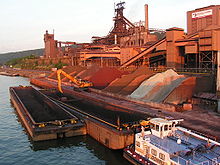 | |
| Industry | Manufacture of basic iron and steel and of ferro-alloys metal industry |
|---|---|
| Predecessor | Sociéte anonyme Ougrée Société des Charbonnages de Marihaye |
| Founded | 1900 |
| Successor | Cockerill-Ougrée (1955) current ArcelorMittal Liège hot products division (Ougrée) |
The Belgian iron and steel producing company Ougrée-Marihaye was formed in 1835 by the merger of the iron and steel works in Ougrée (nr. Seraing) in Liège Province, and the coal mines of Marihaye. The company merged with the Société anonyme John Cockerill in 1955 to form Cockerill-Ougrée.
History

In 1809 the Fabrique de Fer d'Ougrée (English: Iron factory of Ougree) was founded, and in 1834 converted into an integrated works. In 1835 the Société des Charbonnages et Hauts-Fourneaux d'Ougrée (English: Coal and blast furnace company of Ougree) was founded.
In 1892 the two companies merged to form the Sociéte anonyme Ougrée, this then merged with the Société des Charbonnages de Marihaye (English: Coal company of Marihaye) in 1900 to form the Sociéte anonym Ougrée-Marihaye.
In 1905 it merged with the Sociéte anonyme des Hauts forneaux de Rodange (Rodange, Luxembourg). In 1929 it took over the SA des Charbonnages de Fontaine-l'Évêque (English: Coal company of Fontaine-l'Évêque), and in 1931 Alliance Monceau based in Monceau-sur-Sambre.
It was one of the primary metal producers in Belgium; by 1914 it operated 8 blast furnaces, and had a steel production capacity of 500,000 tonnes, producing semi and finished products such as bar, plate, beams and rails. German occupation during the First World War brought much damage to the plant at Ougrée, after the war only two blast furnaces were operational; rebuilding took place between 1919 and 1924. Also between 1905 and 1928 the company operated an industrial rack railway at one of its factories in Ougrée.
In 1923 in association with the Société de l'Air Liquide the company founded the Société Belge de l'Azote, based in Ougrée which produced synthetic ammonia. The negative effects of the 1930s depression caused the company to require financial assistance; restructuring followed; in 1936 the company's facilities in Hainaut became a separate company Aciéries et Minières de la Sambre (AMS), and in 1937 the Rodange plant became an independent entity as Minière et Métallurgique de Rodange (MMR)
In 1955 the company merged with the Société anonyme John Cockerill to form Cockerill-Ougrée.
Legacy
The factory in Ougrée became one of the primary hot production sites of the ArcelorMittal Liège division along with works at Seraing and Chertal. Due to the economic downturn caused by the financial crisis of 2007–2010 blast furnace B temporarily stopped production from spring 2009 to April 2010.
In 2011, all liquid steel production in the ArcelorMittal Liège division was ended, resulting in protests, strikes, and the temporary encapsulation of several ArcellorMittal executives as protest against the closure. The company cited overcapacity, and uncompetitiveness as reasons for the closure; a report by Syndex commissioned by trade unions contradicted the claims of un-competitiveness, claiming ArcelorMittal's reports used biased accounting unions officials called for the liegeois steel industry to be taken into ownership outside ArcellorMittal to protect it.
Notes
- Actually based in Seraing not Ougrée.
- Later to form Thy-Marcinelle et Monceau, a predecessor of Hainaut-Sambre
References
- ^ Toni Pierenkemper (2002). Die Industrialisierung europäischer Montanregionen im 19. Jahrhundert. Franz Steiner Verlag. p. 287. ISBN 9783515078412.
- Caractéristiques des bassins industriels dans l’Eurégio Meuse-Rhin, 2.c. Le défi de l'acier et les premières fusions
- "Usine d'Ougrée-Marihaye". www.industrie.lu (in French).
- David S. Landes (2003). The unbound Prometheus: technological change and industrial development in Western Europe from 1750 to present. Cambridge University Press. p. 465. ISBN 9780521534024.
- ^ Eric Bussiere (1984). "LA SIDERURGIE BELGE DURANT L'ENTRE-DEUXGUERRES : LE CAS D'OUGREE-MARIHAYE (1919-1939)". Belgian Review of Contemporary History (in French). 15 (3–4): 303–380.
- "Le chemin de fer industriel de l'Usine d'Ougrée-Marihaye". www.rail.lu.
- "Aciéries et Minières de la Sambre, Belgique". www.indsutrie.lu (in French).
- "Cockerill Sambre Group -- Company History". www.fundinguniverse.com.
- "ArcelorMittal Liège - Le Primary de Liège". www.cockerill-sambre.com (in French). Archived from the original on 16 June 2011.
- "ArcelorMittal: Un accord pour la relance du haut-fourneau B". www.dhnet.be (in French). 18 February 2010.
- "ArcelorMittal : le haut-fourneau B d'Ougrée a été rallumé". 222.dhnet.be (in French). 14 April 2010.
- Sources:
- "10 000 manifestants sur la place communale de Seraing", www.rtbf.be (in French), 26 October 2011
- "ArcelorMittal : " Le combat est le même pour tous "", www.lesoir.be (in French), 26 October 2011
- ArcelorMittal confirms closures at Liege site, economictimes.indiatimes.com, 14 October 2011
- Silvia Antonioli; Robert-January Bartunek (5 October 2011), "ArcelorMittal executives held in Belgian protest freed", www.reuters.com
- "ArcelorMittal bosses freed after Belgian protest", www.euronews.com, 5 October 2011
- "ArcelorMittall : les justifications de la fermeture liégeoise ne tiennent pas, selon le rapport Syndex", www.rtbf.be (in French), 8 March 2012
Sources
- Suzanne Pasleau (March 2002). "Caractéristiques des bassins industriels dans l'Eurégio Meuse-Rhin". Fédéralisme Régionalisme (in French). 3.
- André De Bruyn (1988). Anciennes Houillères de la Région liégeoise (in French). Editions Dricot. S.A. d'Ougrée-Marihaye (Ougrée), p.181. ISBN 9782870950586.
External links
- 50°36′19″N 5°32′54″E / 50.60517°N 5.54820°E / 50.60517; 5.54820 (Ougrée steelworks), Steelworks in Ougrée, (nr. Liège), Seraing, Belgium
- Documents and clippings about Ougrée-Marihaye in the 20th Century Press Archives of the ZBW